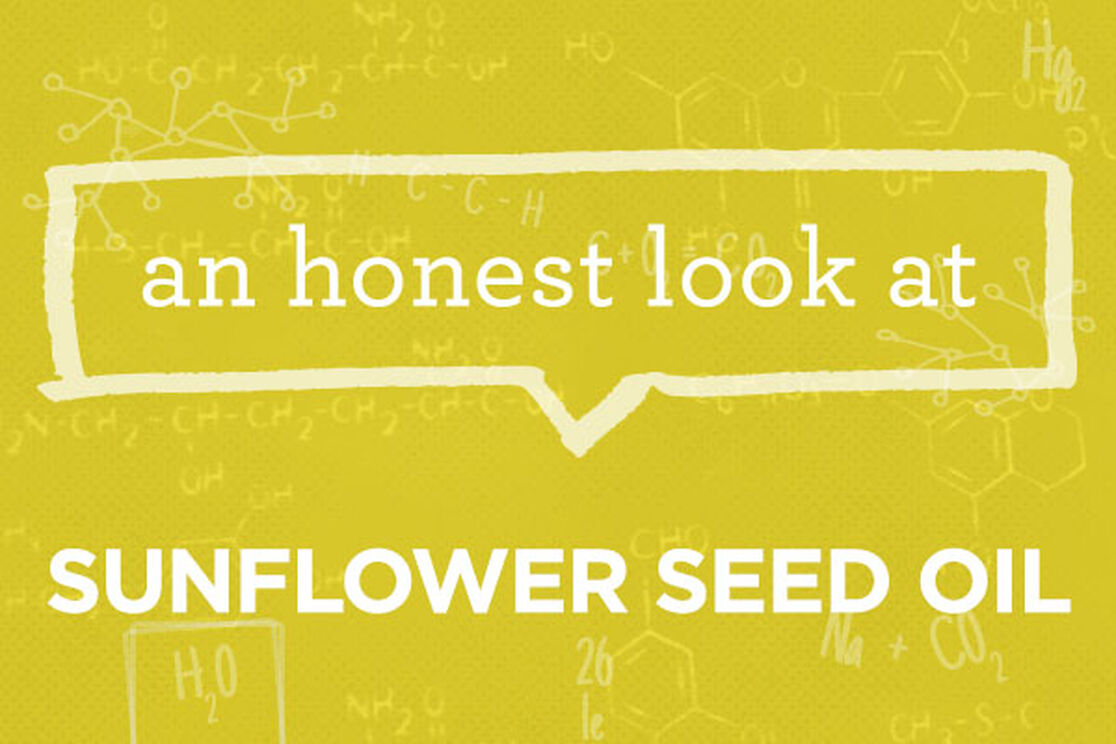This is part of our ongoing series helping consumers better understand chemicals, chemistry, and product formulations. We translate the science, bust the myths, and give you an honest assessment, so you can make informed choices for your family!
Ingredient:
Sunflower Seed Oil
Botanical name:
Helianthus annuus
- Helianthus = Helianthus comes from the Greek helios anthos, meaning “sun flower.”
- annuus = The species name annuus means “annual.”
What it is:
Sunflower seed oil comes from sunflower seeds! It is most commonly extracted using a cold press expeller method, which is essentially squeezing raw materials (e.g., sunflower seeds) under high pressure until all the oil is squished out.
What it does:
Sunflowers have a long and colorful history, beginning as a common crop among Native American tribes. You’ve likely eaten the seeds as a snack or on a salad, but the oil has many uses – from creating cosmetics to cooking dinner. Its uses in body care are still being researched, but preliminary studies show it can benefit skin by helping:
- Moisturize (1,2,3,4)
- Support (1,2,3,4,5,6)
- Nourish (4,6)
Plus, sunflower oil has a high concentration of Vitamin E, which is an antioxidant that helps fight free radicals (7,8).
Why we use it:
In addition to the skin care benefits mentioned above, this wonderful oil is extremely versatile in product formulations. As far as natural resources go, sunflowers are a great choice because they’re drought tolerant, tough, and easy to grow. Plus, as you can see from the studies listed below, this oil is also gentle.
Why we’re featuring it today:
We’ve had customers ask about whether sunflower oil is safe to use on those with related food allergies. According to Food Allergy and Research Education (FARE), seed allergies are uncommon. There is little research documenting the prevalence of a sunflower seed allergy, but they do exist and reactions can be very severe (9,10) which is why we always recommend discussing these types of concerns with your healthcare provider.
When choosing ingredients for our products we take everything into account to ensure a safe, effective, responsible, and delightful product. You’ll find sunflower seed oil in our Organic Shave Oil, Sea Salt + Sugar Body Scrub, and Organic Breathe Easy Rub, among other products.
References:
- Danby SG, AlEnezi T, Sultan A, Lavender T, Chittock J, Brown K, Cork MJ. “Effect of olive and sunflower seed oil on the adult skin barrier: implications for neonatal skin care.” Pediatric Dermatology Jan 2013: 42-50. Print.
- Darmstadt, G. L., Saha, S. K., Ahmed, A. N. U., Ahmed, S., Chowdhury, M. A., Law, P. A., ... & Santosham, M. (2008). Effect of skin barrier therapy on neonatal mortality rates in preterm infants in Bangladesh: a randomized, controlled, clinical trial. Pediatrics, 121(3), 522-529.
- Darmstadt, G. L., Badrawi, N., Law, P. A., Ahmed, S., Bashir, M., Iskander, I., ... & Santosham, M. (2004). Topically applied sunflower seed oil prevents invasive bacterial infections in preterm infants in Egypt: a randomized, controlled clinical trial. The Pediatric infectious disease journal, 23(8), 719-725.
- Stoia, M., & Oancea, S. (2015). Selected Evidence-Based Health Benefits of Topically Applied Sunflower Oil.
- Marques, S. R., Peixoto, C. A., Messias, J. B., Albuquerque, A. R. D., & Silva Junior, V. A. D. (2004). The effects of topical application of sunflower-seed oil on open wound healing in lambs. Acta Cirurgica Brasileira, 19(3), 196-209.
- Darmstadt, G. L., Mao‐Qiang, M., Chi, E., Saha, S. K., Ziboh, V. A., Black, R. E., ... & Elias, P. M. (2002). Impact of topical oils on the skin barrier: possible implications for neonatal health in developing countries. Acta Paediatrica, 91(5), 546-554.
- Quiles, J. L., Ramı́rez-Tortosa, M. C., Gómez, J. A., Huertas, J. R., & Mataix, J. (2002). Role of vitamin E and phenolic compounds in the antioxidant capacity, measured by ESR, of virgin olive, olive and sunflower oils after frying. Food Chemistry, 76(4), 461-468.
- Nachbar F and Korting HC. “The role of vitamin E in normal and damaged skin.” Journal of Molecular Medicine Jan 1995: 7-17. Print.
- Axelsson, I. G. K., Ihre, E., & Zetterström, O. (1994). Anaphylactic reactions to sunflower seed. Allergy, 49(7), 517-520.
- Noyes, J. H., Boyd, G. K., & Settipane, G. A. (1979). Anaphylaxis to sunflower seed. Journal of Allergy and Clinical Immunology, 63(4), 242-244.
We aim to provide you with the most honest and credible information possible. This article was reviewed for accuracy by The Honest Team and was written based on sources that are linked at the bottom of the article.
blog_review_statement



